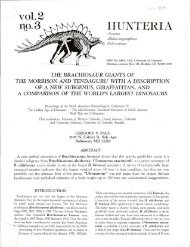THE MANY MYTHS, SOME OLD, SOME NEW, OF ... - Gregory S. Paul
THE MANY MYTHS, SOME OLD, SOME NEW, OF ... - Gregory S. Paul
THE MANY MYTHS, SOME OLD, SOME NEW, OF ... - Gregory S. Paul
Create successful ePaper yourself
Turn your PDF publications into a flip-book with our unique Google optimized e-Paper software.
DINOSAUR <strong>MYTHS</strong> 85<br />
Mongolia and the Kogosukruk delta (see Spicer and Parrish, 1990) regularly<br />
experienced. In particular, none of the models examining dinosaurs as inertial<br />
homeotherms has calculated the heat drain inspired by strong wind chills and<br />
evaporative cooling during winter storms. The reduction of fat insulation in the latter<br />
half of winter would render reptilian model dinosaurs especially vulnerable to such<br />
conditions. The scarcity or absence of small and large crocodilians in well watered<br />
interior and polar dinosaur bearing locales confirms that winter conditions were too<br />
harsh to support bradymetabolic archosaurs (<strong>Paul</strong>, 1988b).<br />
DINOSAURS WERE MIGRATORS EXTRAORDINAIRE<br />
Myth: This is a recent development that reverses the traditional view that dinosaurs<br />
were reptiles unlikely to move very far in a given year. The new model proposes that<br />
dinosaurs migrated up to 6400-9200 km roundtrip each year, especially to avoid the<br />
sunless, florally dormant polar winters (Hotton, 1980; <strong>Paul</strong>, 1988b; Currie, 1989).<br />
This is especially important to help reptilian model dinosaurs to avoid the winter<br />
cold.<br />
Reality: The new model of migrating dinosaurs is valid only up to 2500 km. Modern<br />
polar winters are far harsher than the worst seen in the Mesozoic, and the migratory<br />
abilities of large, long legged polar ungulates and carnivores are broadly comparable<br />
to those of dinosaurs. Polar mammals do not migrate farther than 2500 km roundtrip<br />
per year; beyond this point the energy consumption levels probably are too high to<br />
make it worthwhile even for such high energy animals (<strong>Paul</strong>, 1988b). Migrating herds<br />
are limited by the locomotory performance of their young, and subyearling hadrosaurs<br />
and ceratopsids making their first migrations had shorter limbs than gracile<br />
juvenile caribou, so dinosaurs were not better migrators than ungulates. It is<br />
unlikely, therefore, that polar dinosaurs, living under relatively benign winter<br />
thermal and floral conditions, migrated any farther than their modern mammalian<br />
counterparts if they had similar energy expenditure levels. If these dinosaurs had<br />
reptilian energetics, their movements would have been even more severely limited.<br />
The continent spanning distances that some have proposed are therefore not<br />
realistic.<br />
Certain tropical ungulates migrate from 500 to perhaps 1250 km roundtrip per<br />
year in search of the best feeding conditions (<strong>Paul</strong>, 1988b), some tropical and<br />
subtropical dinosaurs may have done the same.<br />
SAUROPODS DROPPED LARGE CAL YES<br />
Myth: The large pelvic canals and minimum size of sauropods indicates that they<br />
gave birth to large calves, which would be advantageous for such highly mobile giants<br />
(Desmond, 1976; Bakker, 1986).<br />
Reality:' This reasonable idea has been contradicted by new finds of tiny sauropod<br />
hatchlings and eggshells in nest (Mohabey, 1987). It may not be possible for the<br />
members of a clade to abandon calcified eggshells once they have evolved, and the<br />
disparity between the size and intrauterine development of2 kg hatchlings and large<br />
newborn calves would be extreme, so it is probable that all sauropods were<br />
oviparous. As outlined below, this probably had strong advantages for sauropods.









